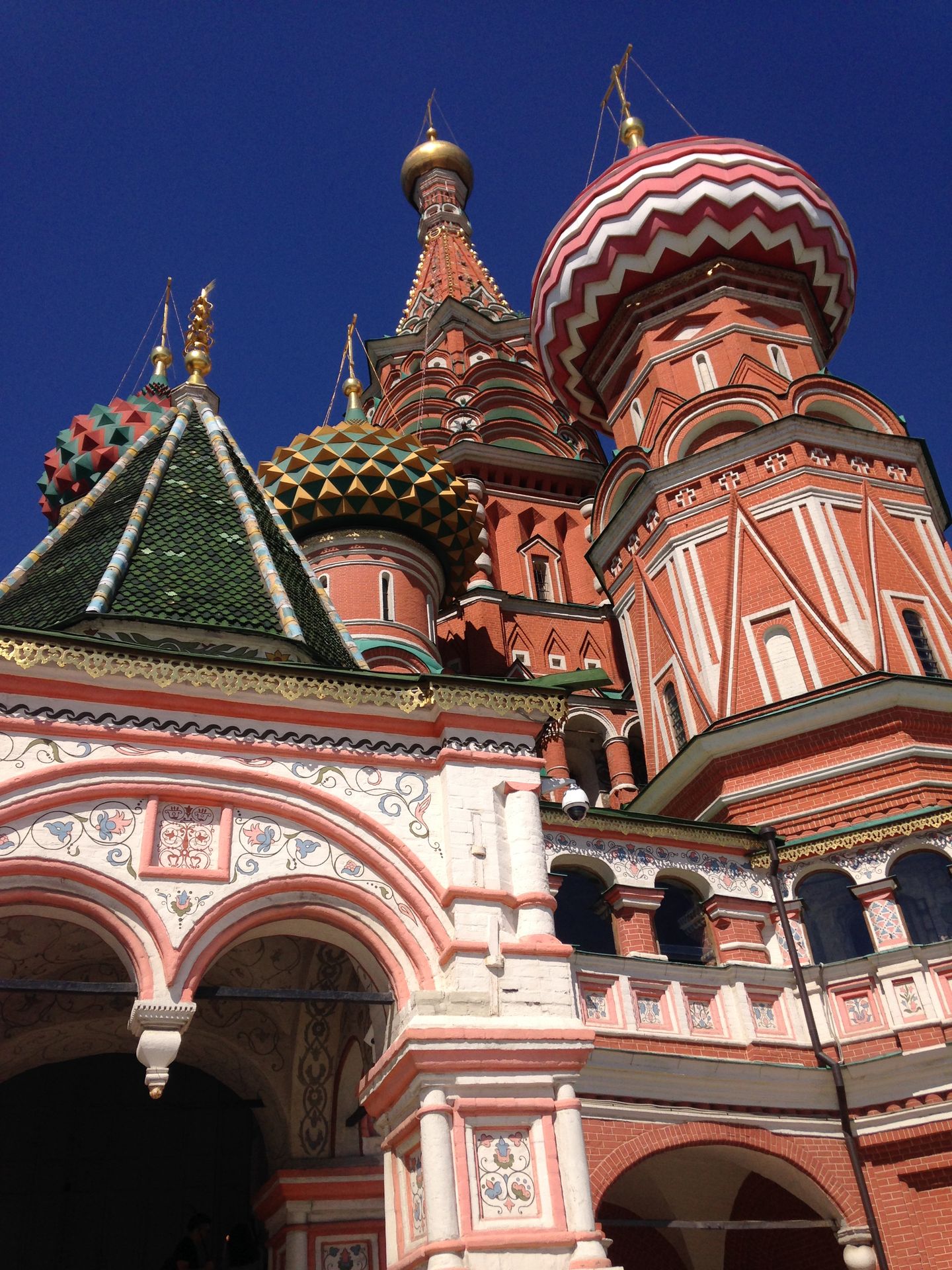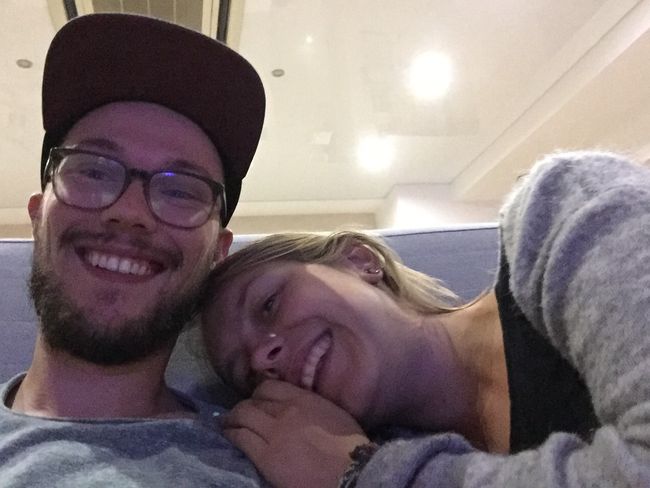Thirteenth Section: Breath-taking Views
Objavljeno: 19.11.2018
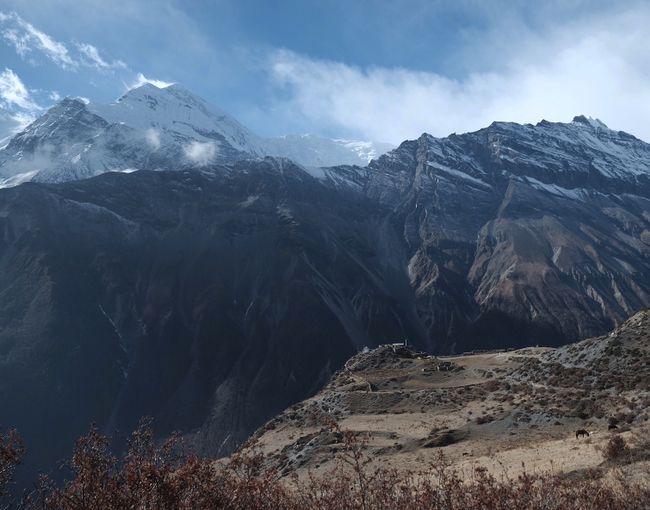
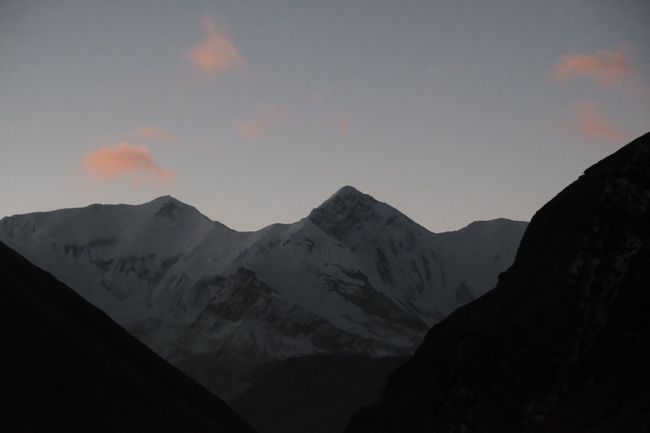
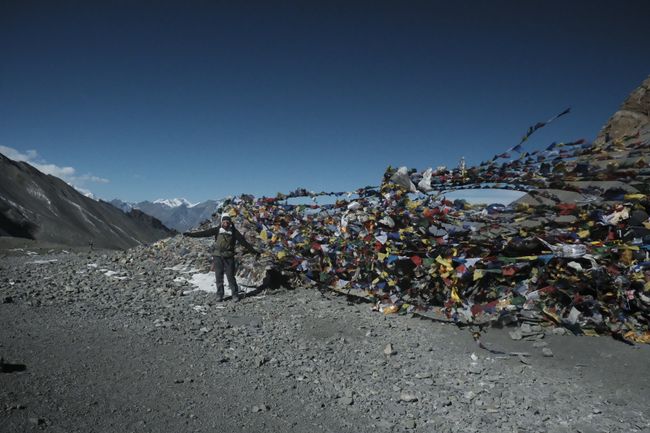
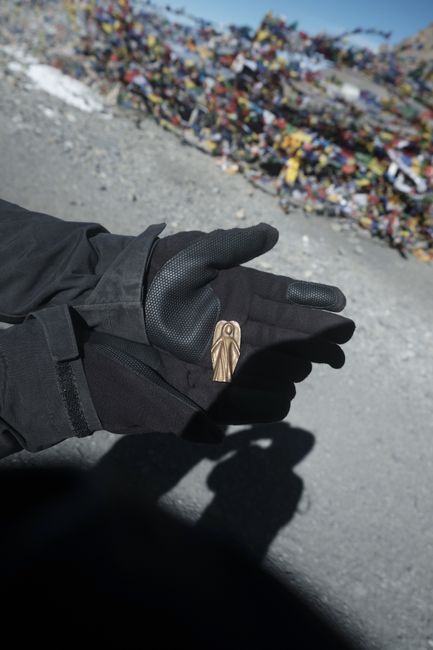
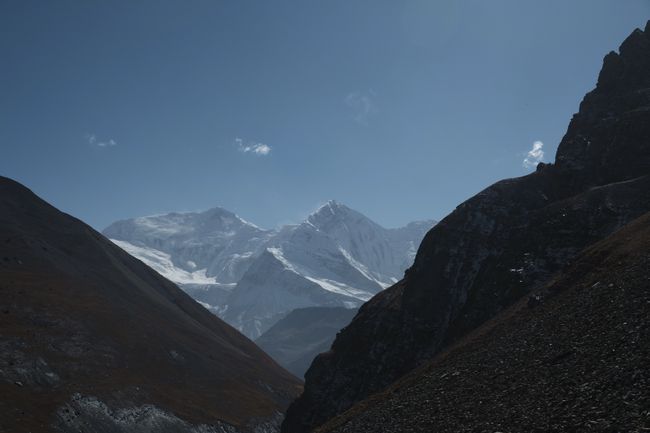
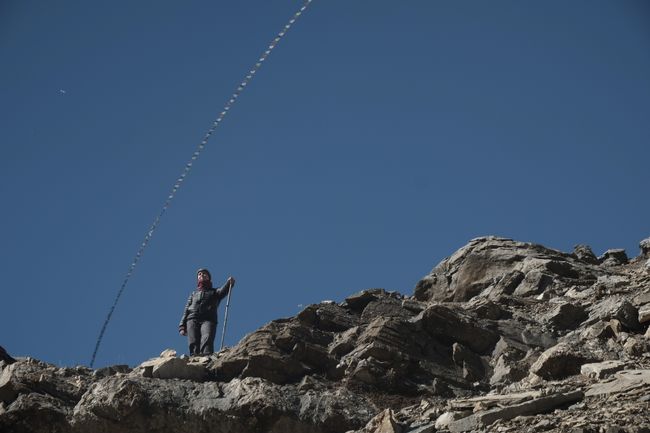
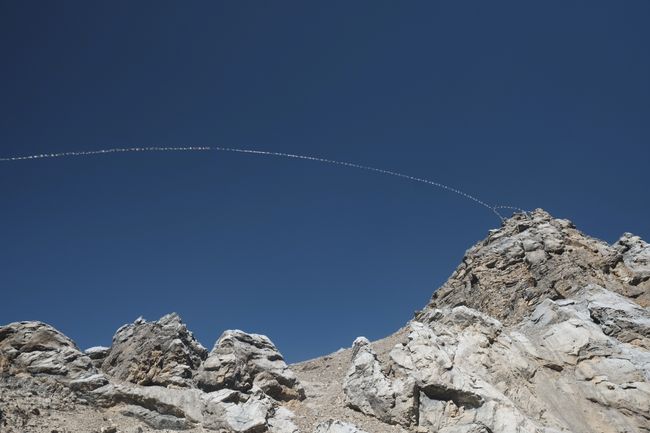
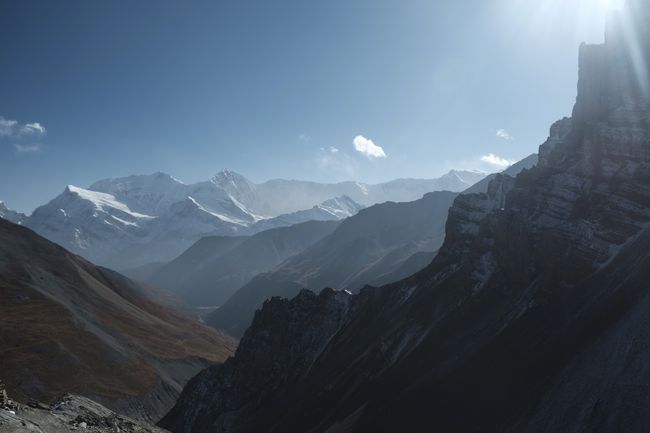
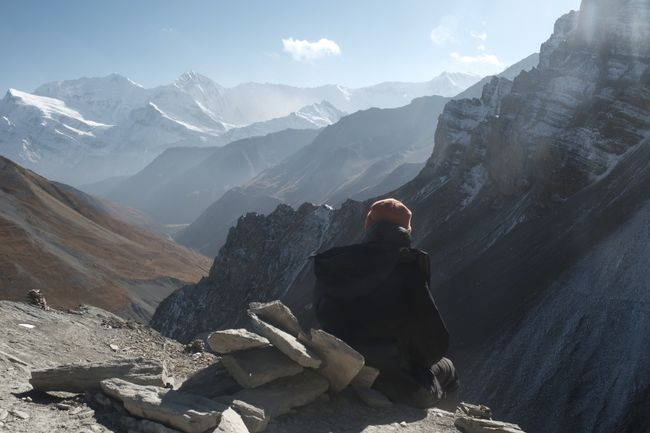
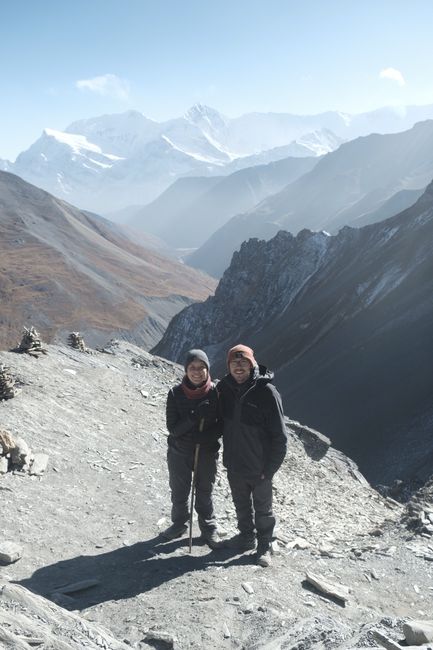
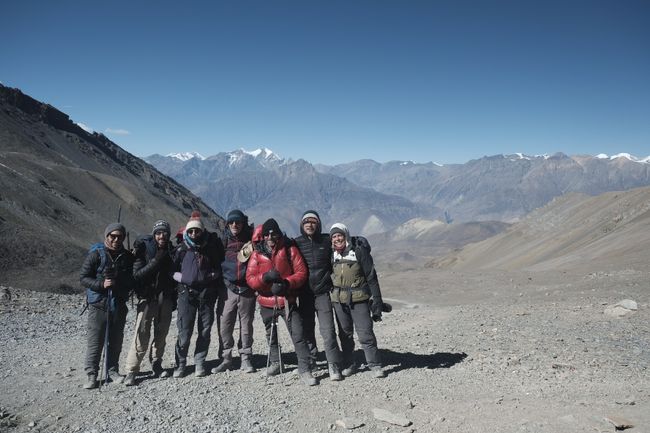
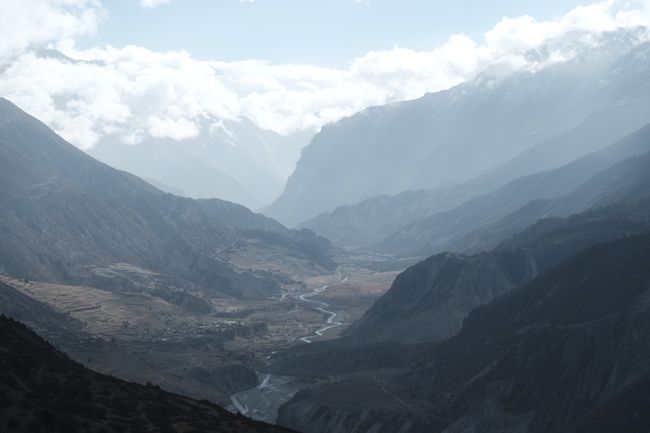
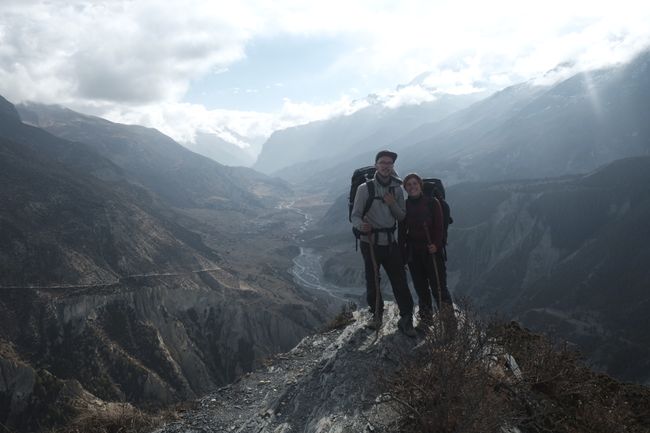
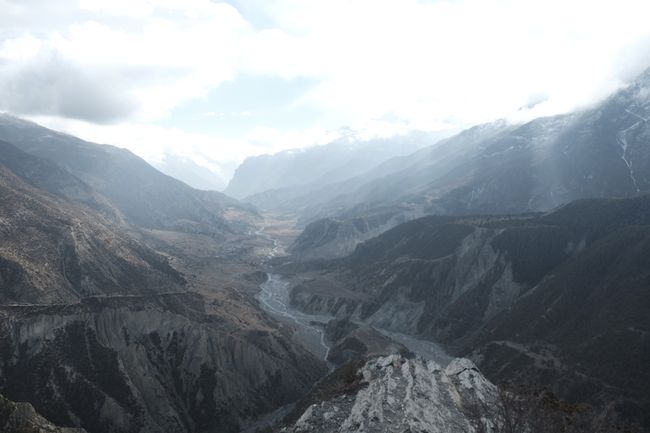
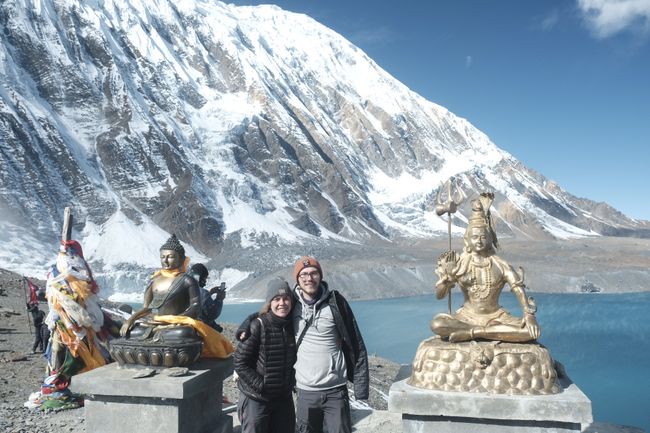
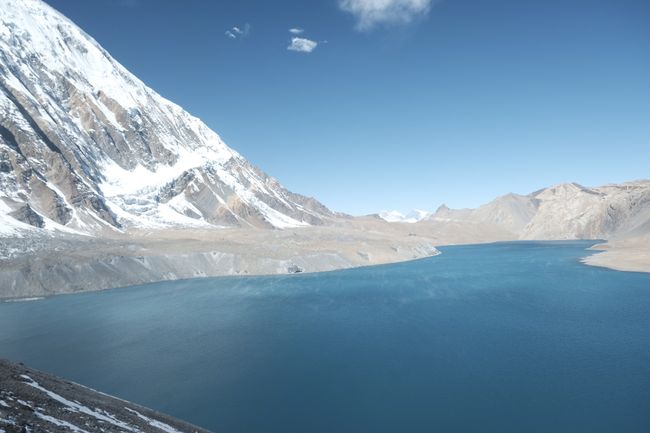
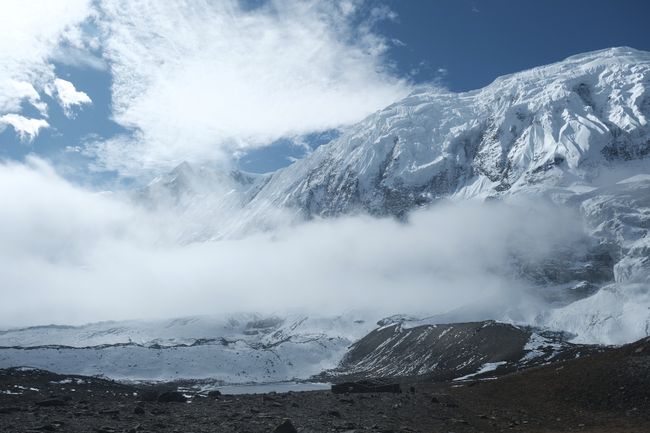
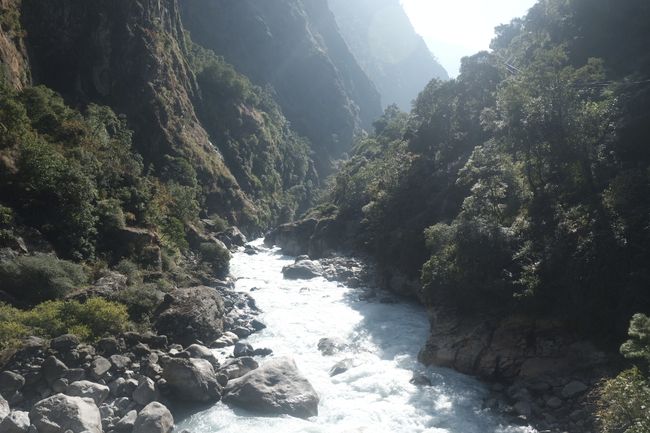
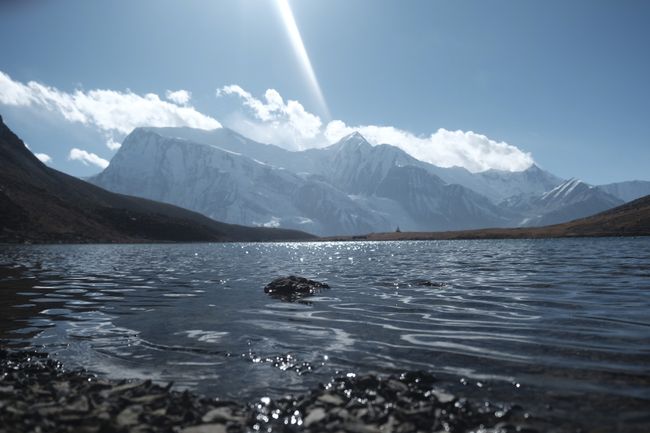
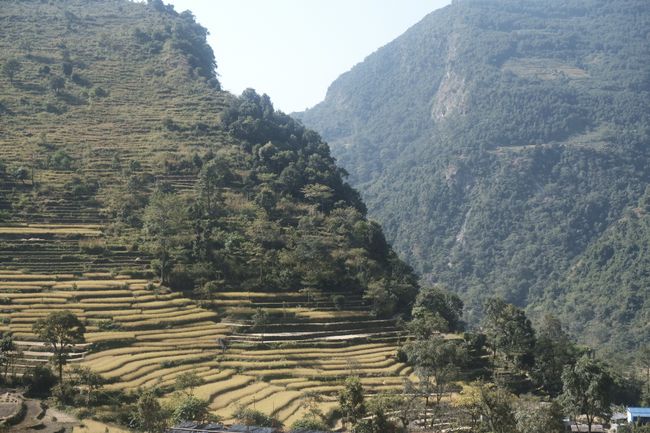
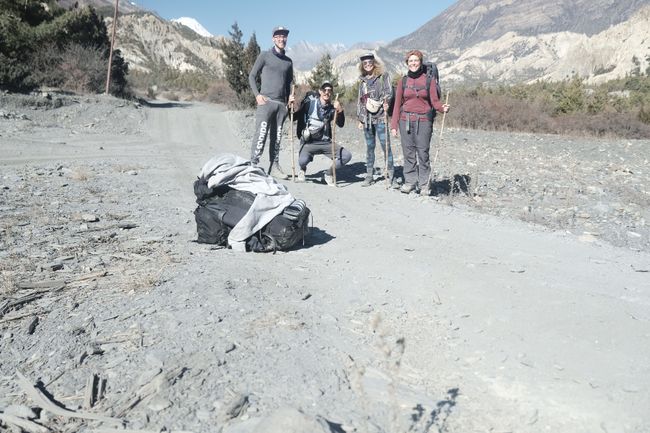
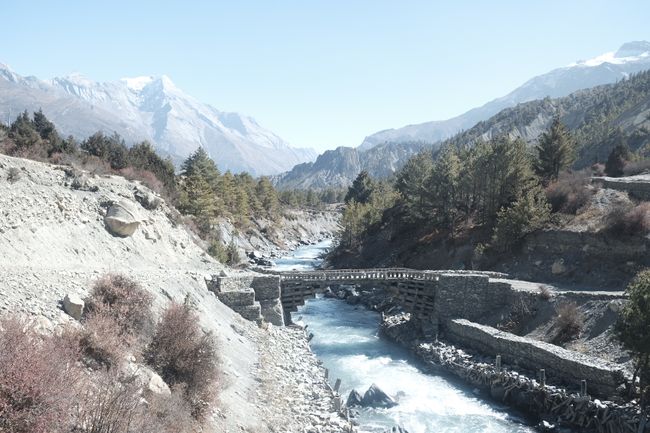
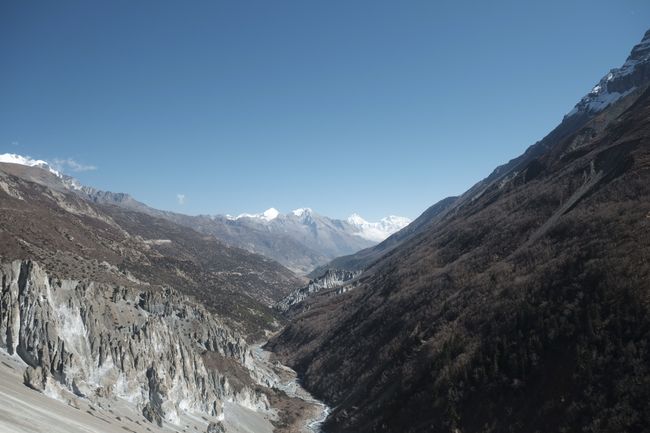

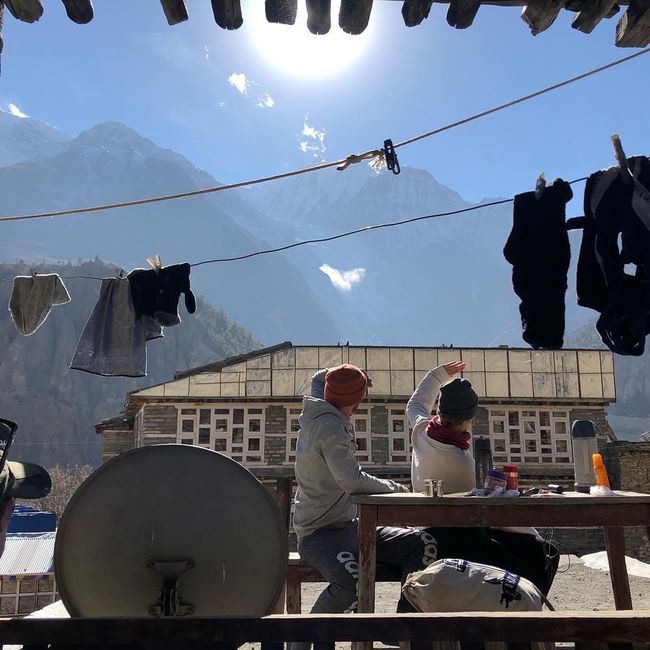
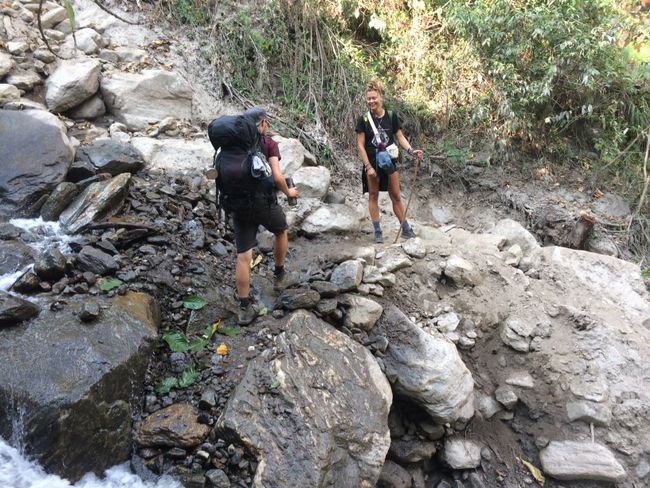
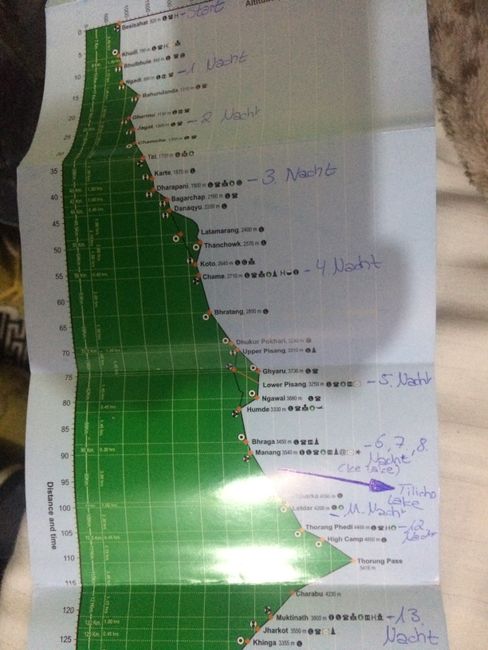
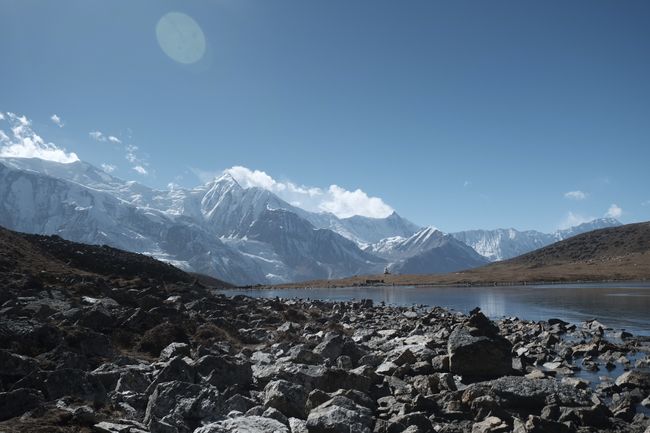
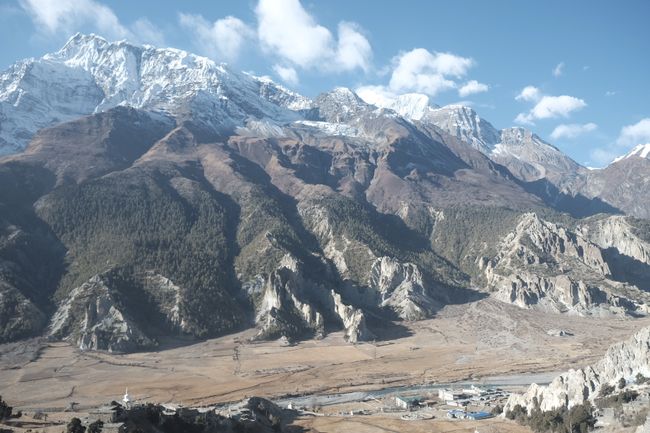
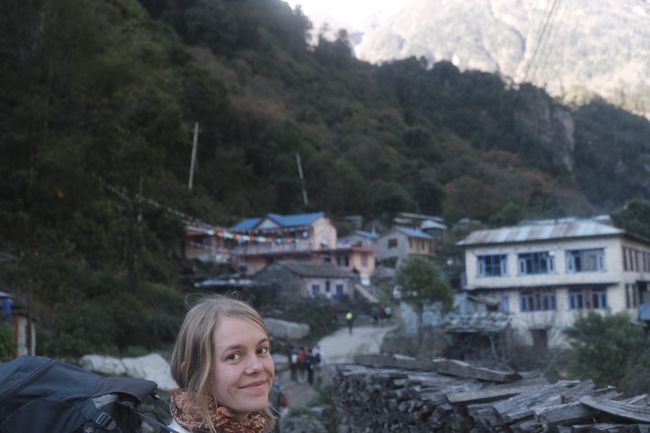
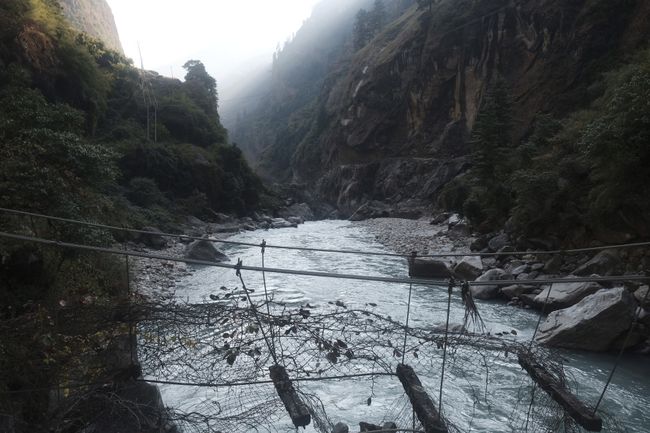
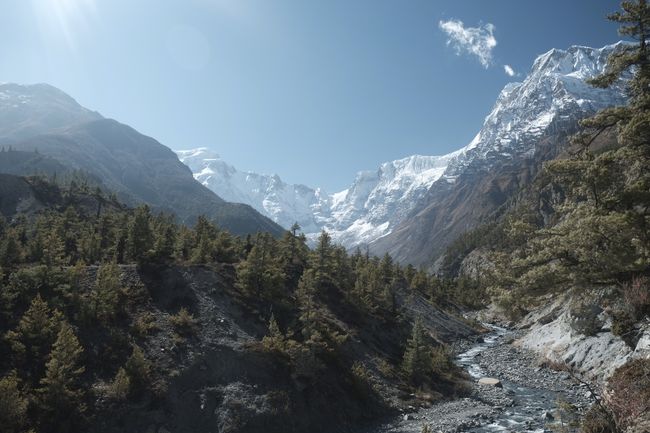
Naročite se na glasilo
Or: My favorite place in the world. Right now, I am sitting on a sun-warmed rock, while the sun's rays warm my face, the wind is icy cold and cutting. Surrounded by the glistening clear water of the river, I am sitting in a valley, surrounded by snow-covered mountain peaks. The sky has a surreal deep blue color. René and I are currently at 3540 meters, higher than you can get in Germany. And yet, we are still at the beginning of our trek.
We are currently hiking the Annapurna Circuit Trek. We started early in the morning five days ago in Pokhara. We sat on a completely overcrowded bus on the floor, trying not to throw up. The serpentine road consists only of an unpaved bumpy road, on which you have to concentrate for five hours to avoid tipping over. When we arrived in Besisahar and finally made it, we decided to continue walking and have lunch later. However, almost everyone from our bus took a jeep and drove to Chame, to avoid having to walk the first part. However, we are very happy that we took the path. We have never experienced before how nature can change and transform within a few days of hiking. At first, we were in a sandy area that was crossed by huge waterfalls. Then we entered an area that seemed tropical, full of palm trees and untamed bushes, interspersed with rice terraces. After that, our surroundings changed to an alpine mountain range. The nights are getting colder and in the mornings you can see frost on the ground. One night there was even an avalanche that covered our uninsulated hostel in white snowflakes. The path always follows a river that fights its way through the mountains. There are many sidetracks, but a large part of the route runs along a, fortunately barely frequented, road. If a car does come by, you have to quickly cover your nose and mouth, as a huge amount of dust is stirred up from the dry road. Now, in Manang, the road will end. Here we will take a day off to acclimatize. This is very important because we are now at an altitude where you can get altitude sickness. Since the air pressure is lower than at sea level, the lungs have to work hard to transport enough oxygen into the bloodstream. Slowly, the body gets used to it and produces more red blood cells, which help in this process. It is normal to get headaches, feel tired, and often not sleep well at night. For example, since I have been up here, I have had strange dreams almost every night. All these symptoms show that the body is working. Wounds hardly heal at this altitude because the body lacks oxygen. This is why the blisters on my feet are not healing at all, but instead getting worse. Due to the changed pressure, you also have to go to the toilet constantly, and I mean really constantly. This can be quite annoying, but it is also normal. If the symptoms worsen, you should not go higher. If you start walking like drunk, vomiting, or feeling like drowning, you have to go down as quickly as possible, as altitude sickness can even be fatal. In fact, a hiker died in the mountains two weeks ago. However, during a lecture on altitude sickness, we were told that this can only happen to very reckless people, as there are very many early warning signs. We actually met a Polish woman whom I would advise to go back home. She complained about her misery, explained that she didn't even know that she had to use the hip belt of a trekking backpack. In addition, after she couldn't go on anymore, she always took a jeep, so she didn't take any time to acclimatize, and to top it all off, she has no travel insurance (How stupid can one be? Either she has to die in the mountains or she has to go into debt for the rest of her life. I didn't think there could actually be such people seriously).
Regarding acclimatization: A good advice is not to climb more than 500 vertical meters per day. So after initially rushing and climbing over 800 meters per day and being completely exhausted in the evenings, the altitude now forces us to slow down. And to be honest, it's really nice. In Manang, we are now taking a day for acclimatization and the next day we want to climb 1000 meters to Ice Lake. Before you wonder (didn't she just mention 500 meters?), it is good to climb to a higher point during the day so that the body can already adjust to it. However, at this altitude, you must not sleep at all! But more about Ice Lake later.
Since the first day, we have been hiking with two New Zealanders, Nathalie and Ben. They are both super fit, even though they smoke weed all day long, don't have proper hiking shoes and don't even have a sleeping bag with them. While Ben sometimes takes small breaks to look for wild marijuana plants, we still find it quite difficult to keep up with them. They overtake almost everyone and race through the surroundings. We also are never overtaken and are quite fast, but we always have to arrange meeting points with them because we simply can't keep up with them.
The hostels on the trek are usually not insulated, rarely have hot showers, and boast about wifi, which they don't actually have. We even once had a hostel near a hot spring and that was, honestly, just amazing. We rushed the first few days just to arrive at the spring at noon, and it was definitely worth it. Our first hostel was beautifully located right by the river, but we were constantly asked by the grandmother if we wanted to buy hash, a stick, or many other things, while her grandchildren tried to search the bags lying on the table. However, the worst hostel we had was in Manang yesterday. When we arrived there, there was not a single free room in the whole town. So we went to the most run-down house we could find and lo and behold, there was room for all four of us. The rooftop terrace was sunny and we had a wonderful view. We even observed a small avalanche crashing down the mountain. But then we saw it on the floor: everything was full of rat droppings, you could see where the animals had gnawed in the corners. But Nat and Ben, as always, were not bothered by it. They assured us that the rats would not come when there were people there. So we spent a very relaxed afternoon in the hostel, went to the lecture on altitude sickness, and returned in the evening to cuddle up in our room, which was once again much too cold. And then it happened: above us, you could hear the rats running and squeaking. René and I jumped up screaming and made it clear that we would not spend a single night in the Rat's Palace. So we set out to find a place to sleep in a completely overcrowded place, as we already knew from five hours earlier. Several Russians were also looking for a place with us who had probably arrived too late. In a really nice hostel next door, we actually got a room because a very nice Australian saw how desperate we looked and switched to the dorm and gave us her single room. We offered our rat room to the Russians and they seemed very excited to finally have a room. Nat and Ben told us the next day that the Russians had also left. Our two friends had a terrible night in the Rat's Palace: We all decided to take preventive altitude medicine. One of the side effects is that your limbs go numb. While all of us (except René) struggled with numb fingers, Nat had a completely numb half of her body. In addition, the rats had a huge party during the night, squeaking, romping around, and to top it all off, even dropping a rat turd on Nat's nose. One rat fell from the ceiling in the neighboring room, they reported, and you could hear a huge bang and then a loud rat scream. However, we had a wonderful night in our hostel, ukulele was played by the fire and sung along. We were overjoyed not to have to sleep in the rat nightmare. Unfortunately, Nat and Ben decided not to do the two-day trek to Tilicho Lake, so after our beautiful day off together, our paths diverged. René and I went on the first day without Nat and Ben, as mentioned before, to Ice Lake. It was very exhausting because at this altitude, you run out of breath just climbing a staircase. I felt very bad in the first few meters and was afraid that I was still suffering from altitude sickness. Thoughts raced through my head like fever dreams, and when we stopped, I had an incredible desire to just fall asleep. René gave me two chocolate bars and lo and behold, I felt much better. At the teahouse, we took a long break, where we breathed deeply and ate a lot. After that, I felt much better and we continued with two Germans we had met there. At Ice Lake, we enjoyed the beautiful view (even though the lake itself was not so beautiful) and had long conversations. And then, the next day, we set off for Tilicho Lake. We were really fast now and knew how to breathe properly to get enough oxygen. When we arrived at the base camp of Tilicho Lake, René was unfortunately not feeling well at all. He had a terrible sore throat and went straight to bed while I wanted to finish reading the fourth Harry Potter book (which wasn't easy because in the common areas, there was always someone to have a nice conversation with). But the next day, René was already feeling much better. We defrosted our bottle, which was already frozen in our dorm, and then walked up to the lake. Many people had warned us about the strenuous ascent to the lake, but thanks to our experience at Ice Lake, we were well prepared here too, unlike many Nepalis. Since Tilicho Lake is a sacred place, many locals drive by jeep to an altitude of 3540 meters (what did we learn?! Ascend slowly!) and then continue to the base camp (4150 meters) and go to the lake at an altitude of around 5000 meters the next day. Instead of going steadily, many Nepalis take three steps and then, completely out of breath, stop. So we overtook a lot of reckless people who didn't listen to the warning signs that are posted everywhere. Later we learned that many locals believe that people with impure hearts will not be able to make the ascent. Therefore, no one wants to admit that the ascent is too difficult for them. The day was terribly cold and cloudy, and so we walked surrounded by snowflakes to the lake, where we spent hardly fifteen minutes because it was simply too cold. On the way down, we saw a Nepali who had to vomit. So he definitely had to go down. However, his young companion said it would be nice to sit in the warm teahouse. We offered to accompany the older man, we shouted and tried to make it clear to him how dangerous it was to stay up there. But unfortunately, no chance. So we went down without him. In the next hostel, we met Caro and Johannes in the evening, a super lovely couple from Frankfurt, and we spent a nice evening together. We also spent the next night with them in a hostel and got to know a few other people there, thanks to the cold, who cuddled up with us by the fireplace and asked in vain for more firewood (one piece should be enough while the snowstorm raged outside). There we also met Adi and Gal, two Israeli brothers. I offered Adi a place next to me by the fire, to which he said that he was Israeli, and if he wanted something, he would just build a wall around it. And boom! The ice was broken. Gal asked us about the symptoms of altitude sickness, and after we all bragged about our very scary knowledge, he ran to the toilet and vomited. Luckily, there were two doctors with us at the hostel who quickly reassured us and explained that Gal only had something wrong with his stomach. And so we all went towards the pass the next morning, Gal without a bite of food in his stomach. We all stayed in the same hostel on the edge of the mountain and went for a short walk to the viewpoint together, and the next morning, at six o'clock on the dot, we set off for the pass. It was around -10 degrees and so windy that we had to hold onto the ground over and over again. Snot ran out of our noses and blew away in the wind. Unfortunately, this ascent was absolutely not romantic, and yet when we finally reached the pass at 5416 meters, it was beautiful. Adi instructed us to only look at the ground and on his command, right at the top of the pass, we opened our eyes and fell into each other's arms. It was like New Year's Eve, only much much more beautiful. Unfortunately, it was so windy up there that taking photos was practically impossible, and you could only fight your way backward towards the prayer flags. The best moment was when we took my grandma's little lucky charm out of my pocket and took a photo for her. Somehow, they had accompanied us on our way.
On the way down, I had to cry because I was so happy to have made it. With our great group, we walked through a desert-like area. The nature here is so changeable. We spent the night again in freezing cold, which is why we decided to take a jeep to Pokhara at 5:30 a.m. the next day to get back to warmth as quickly as possible. We were lucky to ride with really nice people in the jeep, but I felt nauseous again for the entire drive. Like in a commercial for jeeps, we drove through rivers, over rocks, and small cliffs. René kept bumping his head and the bus in front of us wobbled back and forth. Then we had to wait for two hours when a landslide blocked the road for a few cars in front of us. After 13 hours, we finally arrived in Pokhara and then went out to eat with Gal and Adi, finally not eating Dhal Bhat! We didn't eat anything else in the evening for the entire trek.
We spent the first day in Pokhara getting René's shoes repaired, doing laundry, thoroughly showering ourselves, and going to the hairdresser (who unfortunately slapped a huge amount of oil on my hair, so it immediately looked like I had been hiking). In Pokhara, you always meet great people, and it feels more like its own little world and less like Nepal because there is everything from fancy restaurants to small bars with projectors. So we met Nat and Ben for lunch, were thrilled to see them again, and went to watch Fight Club in the evening. Finally clean and warm!
The unpleasant sides of the pass:
At night, it is often so cold and windy that it is difficult to sleep, and the altitude makes sleep very difficult anyway.
You need all your clothes and can hardly wash anything. So we usually wore our socks for 3 consecutive days, and I only had three different tops during the 13 days, so you feel pretty dirty, but hey, everyone is disgusting on the trek!
There are hardly any hot showers, and if there are, the outside temperature is so cold that you don't want to shower anyway. During the day, it is so sunny that we almost always had a sunburn on our faces, despite a lot of sunscreen.
Why you should still do the Annapurna Trek:
The nature is simply beautiful and changes incredibly strongly. You learn to push your limits and meet super lovely people. It is an unforgettable experience!
Packing list for the Annapurna Trek:
-Warm clothes and a good sleeping bag! And don't bring too many things. One long-sleeved shirt, one sweater, one T-shirt, hiking pants, shorts, long underwear, a super thick jacket, gloves, a hat, and waterproof hiking shoes, plus at least two pairs of hiking socks.
-Clean clothes for the evening (I had tights and a dress with me, which is really practical for the way to the shower)
-No pajamas or anything like that, you sleep in the clothes for the next day because it's so cold
-The hostels at the beginning of the trek don't cost anything, but you have to have dinner and breakfast there. Nevertheless, it is recommended to only order something small in the morning and hot water to make tea (we had fresh ginger and honey), instant coffee, and porridge (1.5 kg for two weeks).
-Peanut butter, cookies, and apples are the perfect snacks in between!
-A life straw! A bottle for filtering water, which saves a lot of plastic waste, and you can easily refill it in rivers along the way.
-A large power bank, as you can no longer charge your devices above 3000 meters.
-Wet wipes as a substitute for showering (unfortunately, we didn't have them with us)
-Earplugs, as Nepalis always have some kind of festival that they celebrate with loud music, singing, and dancing
-Medication! Especially for altitude sickness, but also for anything else you can get. And don't forget blister plasters ;)
-An e-reader, camera, cellphone, a deck of cards
-Toiletry bag
Naročite se na glasilo
Odgovori
